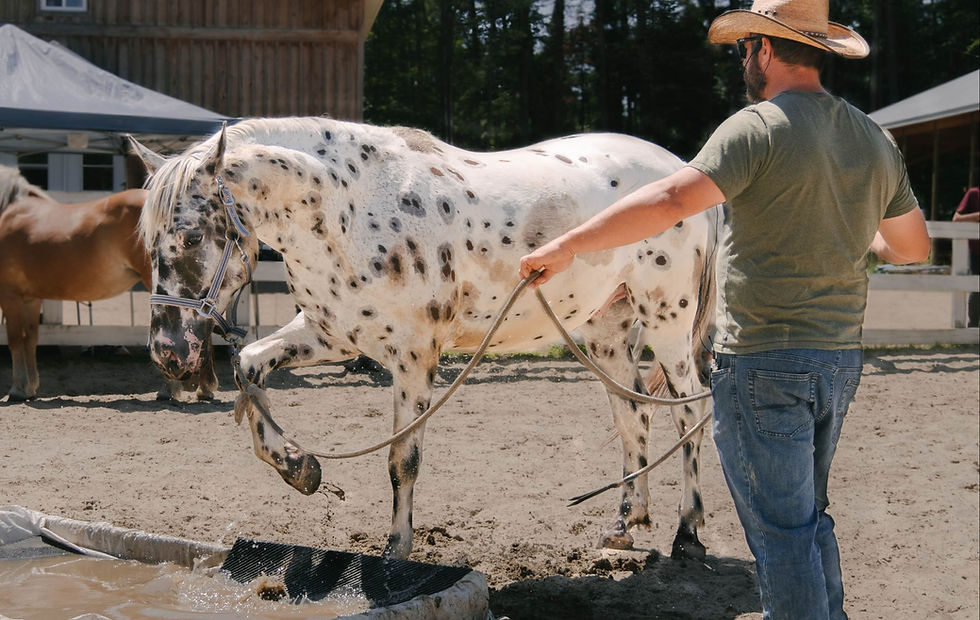Do you work in sequence?
- Éric St-Arnault

- Nov 7, 2022
- 3 min read
This month, I'm talking to you about the importance of working in sequence when training with your horse.
In the world of horses, it is often said that it is important to end on a high note; that is to say, when we ask for something new from our horse, we end the exercise as soon as he succeeds in it the first time.
This popular belief is unfortunately false. The problem is that people rely on the fact that the horse will only register for the last portion of the training.
Take for example the exercise of getting into a trailer. If you had 15 refusals and 1 success, people assume that the horse forgot all 15 refusals and only understood the one success. This is not always true, and it is even rarely the case. The horse won't understand that it's only the one time he's done the right thing that he's achieved what you expect of him.
The horse learning method does not work like that. His intelligence is not based on logic. On the other hand, his strength in terms of intelligence is not only memory, but also the ability to adapt. And it is thanks to these faculties that they have been on Earth for thousands of years, adapting to their different ways of life. This also makes them routine animals who will also find it very easy to anticipate requests. Moreover, a horse that anticipates is an intelligent horse that will be able to predict requests even before they arrive, because requests are always made in the same way. This is the very proof that the horse when working in a routine or sequence, will be able to adapt and respond to demand.
So if we go back to our example of the trailer in which we created a sequence of 15 refusals to mount and 1 success; Assuming that the horse learns through sequences and repetitions, the repetition of failure is greater than that of success.
I chose the example of getting in the trailer, but this can be applied to all sorts of requests, such as exercises, going on a hike, going through a water hole, over an obstacle, etc.
This is why I prefer to be less demanding in my request by lowering my objective. If we go back to our example, instead of asking my horse to completely get into the trailer, I'm going to ask him to simply feel it or just put his front legs. But I'm going to go create a sequence for him.
A sequence is 3 to 5 repetitions in a short period. From 3 to 5 times, the horses will begin to understand and remember what is asked of them. Once he succeeds in the sequence of the same exercise 3 to 5 times without failure between 2 requests, the next day, he will be able to remember that it was the request. When you have created a sequence of 10 or 15 refusals and only one success, the next day your horse will repeat the failure and not the success because of the way the horse learns. Sequences of small successes are much more effective in the long run for me than having succeeded once at a more complex task.
Remember that the notion of success or failure in the horse does not exist. This is a human concept only! The horse that has not been in the trailer will not return to its paddock, thinking it has not succeeded in its exercise. On the other hand, he will associate a sequence of certain behaviours with relaxation, and the sequence that you consider a failure is what he will remember. In our example of 15 refusals to get into the trailer and one success, he will associate the correct answer with not getting into the trailer.
This is where it is more important to have smaller successes (feel the trailer or put the front feet) but repeat them several times. On the other hand, it will be important to mount the objectives quickly and to repeat the sequences several days in a row. So once he is able to succeed in the sequence of feeling the trailer, he must mount the objective, put his feet inside then climb completely and finally stay a minute before disembarking.
Finally, when faced with failure, it is important to decrease goals quickly. If we continue with our example of getting on the trailer, after two attempts to get on you have had two failures, so quickly you need to cut your goal in half in order to establish streaks of success and not streaks of failure. When your horse succeeds in the sequence on the decreased objective, then you increase your goal in order to continue to create sequences of successful sequences.
Thanks to this method, you will print in the memory of your horses the behavior requested in the face of your requests.
Good training!




Comments